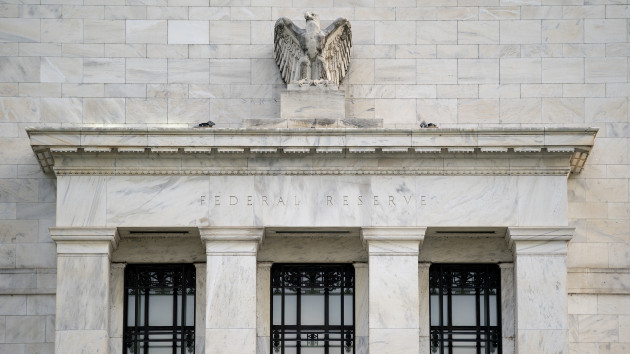What ‘soft landing’ means and the chances it will happen
(NEW YORK) — For well over a year, inflation has slowly sunk many U.S. households, soaking up Americans’ savings.
The aggressive fight against inflation by the Federal Reserve has heightened the risk of a downturn that could put millions out of work.
But the central bank hopes it can cool off price hikes without sending the economy into a recession, accomplishing a best-of-all-worlds outcome known as a “soft landing.”
Last month, Fed Chair Jerome Powell said he sees a path to a soft landing at an event at the Brookings Institution.
The central bank faces major obstacles in achieving the feat since it lacks precise tools for guiding economic performance and faces factors like the Russia-Ukraine war that extend beyond its control, economists told ABC News. Still, a soft landing remains within reach, they said.
Here’s what the term “soft landing” means and why it poses a challenge:
What is a soft landing?
The term “soft landing” refers to an effort on the part of the Fed to slow the economy and bring down inflation, while preventing the U.S. from entering a recession.
The Fed has imposed a series of interest rate hikes in recent months as it tries to slash price increases by cooling the economy and choking off demand. The approach, however, risks tipping the U.S. into a downturn and putting millions out of work.
Despite recession fears, the Fed is also concerned about raising interest rates too slowly.
When facing high inflation, policymakers fear what’s referred to as a price-wage spiral, in which a rise in prices prompts workers to demand raises that help them afford goods, which in turn pushes up prices, leading to a self-perpetuating cycle of runaway inflation that can be difficult to reverse.
“A soft landing would be a rapid slowdown of inflation without a big rise in the unemployment rate,” Joseph Gagnon, a senior fellow at the Peterson Institute for International Economics and a former Federal Reserve official, told ABC News. “It’s very, very tricky.”
What does the term “soft landing” refer to?
When used figuratively, “soft landing” typically refers to the smooth landing of a plane.
“Most flights are soft landings,” Alan Binder, a professor of economics and public affairs at Princeton University who studies monetary policy, told ABC News. “Occasionally you get a hard one when the pilot doesn’t quite get it right and it’s ‘oh, I felt that one.'”
Economists told ABC News they consider the metaphor apt, since the process of landing a plane captures the careful guidance necessary to steer the economy down from high inflation.
What makes a soft landing difficult?
Central banks struggle to achieve a soft landing because it requires the delicate navigation of economic conditions, even as central banks lack precise tools and face some factors outside of their purview, economists told ABC News.
The primary tool deployed by the Federal Reserve in its fight against inflation is the interest rate hike, which increases borrowing costs, essentially making it more difficult for individuals and businesses to access loans.
In theory, the move cools demand and brings down prices. But the instrument is a blunt tool with uncertain severity that can take months to achieve.
“The central bank doesn’t have absolute precision instruments,” said Blinder. “Nor can it forecast with great accuracy where the economy would be if it does nothing.”
Since rate hikes cause the economy to slow down — which often lead to layoffs — the Fed’s use of interest rate hikes to attack inflation risks replacing one problem with another, Yeva Nersisyan, a professor of economics at Franklin & Marshall College, told ABC News.
“The way I see it is we are using unemployment as a tool to fight inflation,” she said. “It’s basically saying we want lower prices for all of us at the expense of some people, potentially millions, losing their livelihoods.”
In addition, the Fed faces economic forces beyond its control.
As with many economic issues, inflation boils down to an imbalance between supply and demand, as excess demand sends prices upward. Fed interest rates, however, only address the demand side of the problem.
In the current crisis, a pandemic-era supply bottleneck has eased but remains a key issue amid the Russian invasion of Ukraine and COVID lockdowns in China.
“The Fed is still fighting against these supply constraints, though those are dissipating,” Blinder said.
Will the Fed achieve a soft landing this time around?
Economists differ on whether the central bank will achieve a soft landing as it dials back the current bout of inflation.
Morgan Stanley recently forecasted that the U.S. would narrowly avert a recession next year, allowing for a soft landing. JPMorgan Chase CEO Jamie Dimon, however, said last month that a soft landing is unlikely.
Gagnon, of the Peterson Institute for International Economics, put the chances of a soft landing between 50% and 60%, including the possibility of a “very, very mild recession.” Yeva said a soft landing is possible but unlikely.
Blinder estimated the odds of a soft landing at about 40%. If the Fed doesn’t achieve a soft landing, it won’t be for lack of trying, he said.
“This Fed is clearly trying for a soft landing,” Blinder said. “That’ll be a test of both its skill and its luck.”
Copyright (C) 2022, ABC Audio. All rights reserved.

